Tropical fish species are a beautiful addition to the home aquarium, and angelfish make the cut. Besides their bright and vivid appearance, angelfish is also interactive and a fun species.
If you are a beginner aquarist or one handling angelfish for the first time, knowing about their lifespan is a common factor. Angelfish live a longer life spanning 10-12 years compared to other species.
This detailed article will answer all your questions regarding how long do Angelfish live. Also, we’ll explore easy tips and strategies that can help prolong the lifespan of the fish in captivity.
Table of Contents
How Long Do Angelfish Live in Captivity?
The standard lifespan of an angelfish in a home aquarium is between 10-12 years. Besides their appearance and large size, angelfish is a hardy species to grow in captivity.
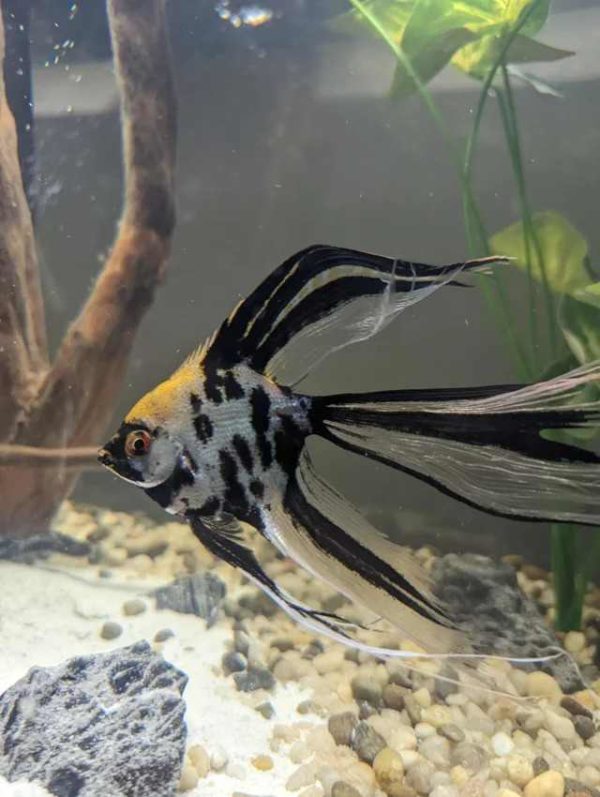
They withstand changes to water parameters, but they are also easy to breed and raise. The only concern with an angelfish lies in its aggressive behavior. Since they are territorial, you need to keep them in larger aquariums for a comfortable life.
The genetics and the initial breeding condition of the angelfish contribute to its lifespan. If you picked them up from a random pet store, the chances of poor breeding conditions are quite high in that case.
How Long Do Angel Fish Live in A Tank?
Like raising them in captivity, an angelfish can live up to 12 years in a tank. However, they require optimal care and maintenance, especially with the water parameters.
Besides that, we’d recommend buying them from certified pet stores that prioritize clean and safe breeding conditions. The genetic lineage of the angelfish plays a crucial role in the overall quality.
Since they have a unique shape and appearance, angelfish survive better in taller aquariums than horizontal ones. Also, you have to keep them in groups. A minimum of two and a maximum of six is favorable.
How Long do Angelfish Live in The Wild?
Much like in captivity, an angelfish can live up to a decade in the wild. However, their lifespan is often cut short due to predators and diseases.
Predators like barracudas are prevalent in the water bodies they live in. So, they are at heightened risk of getting eaten. Besides attacks, angelfish also contract diseases like Ich and Gold dust disease in the wild.
These are fatal diseases that can claim their lives over a short time. The reason why angelfish have a comparably shorter lifespan in the wild is due to the ongoing struggle.
Besides the fear of getting eaten, angelfish also has to search for food, sustain poor water conditions due to pollution, etc.
How Long Can Angelfish Go Without Food?
Like most fish species, even angelfish can fast. On average, they can last up to three days without food. However, there are risks with not feeding your angelfish in captivity, especially in community tanks with smaller fish species.
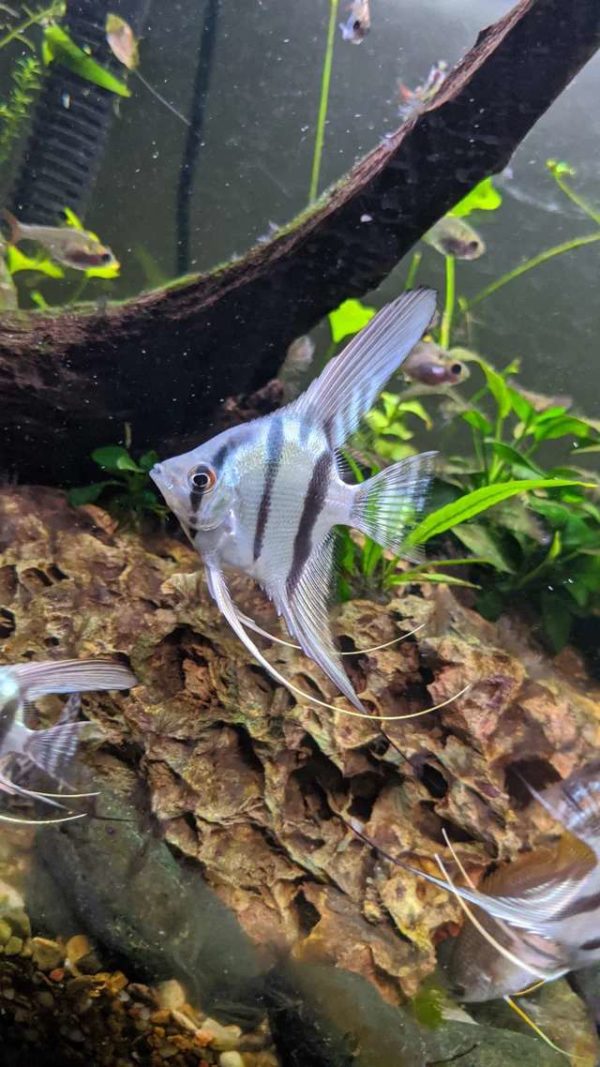
The mature and adult angelfish can go up to two weeks without food. However, lack of proper diet makes them irritable and aggressive. In such instances, they can become predatory and eat the smaller fish in the tank.
When it comes to their feeding habit, they predominantly rely on fish food and occasionally on plants. Try to provide them with a blend of two to have optimal nutritional balance. The fry and juvenile angelfish rely on live foods more than plants.
How Can You Tell How Old an Angelfish Is?
Determining the age of an angelfish can be a difficult task. However, three primary factors can ease the process for you, including:
- Body size
- Size of the eyes
- Behavior
When the angelfish is a fry, ranging between 0-3 months, they grow up to 2 inches in length. During 3-6 months, angelfish grow up to 4 inches. During 6-12 months, they grow up to 8 inches.
Also, if the eyes of the angelfish are larger compared to their body proportion, it is a sign of stunted angelfish growth. This means that they are grown adults where organs have grown to the max size, but their body hasn’t.
As for the behavior, an adult and mature angelfish has become more aggressive with other species in the tank. This is to exert dominance and secure themselves at the top of the hierarchy.
How to Improve Angelfish Longevity?
Now that you know how long angelfish lives, it is time to focus on the additional factors. How can you improve their lifespan?
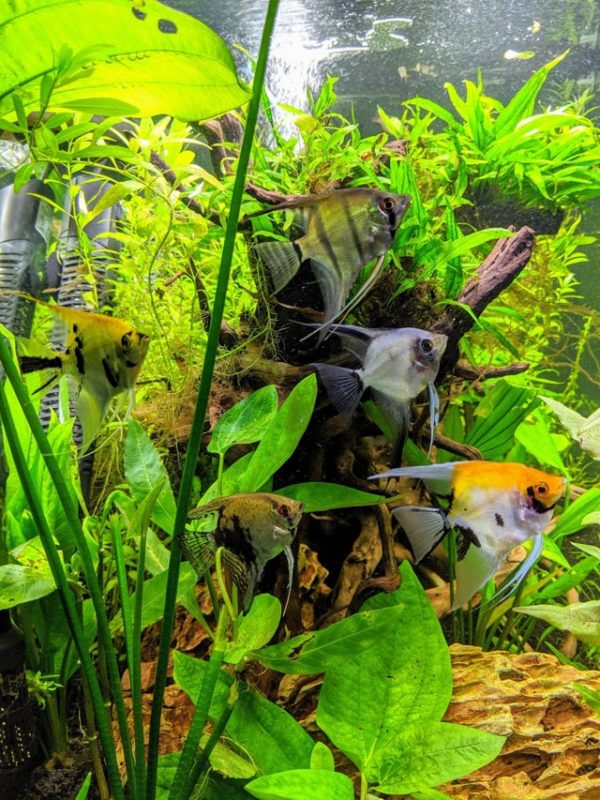
Typically, the quality and genetics of the fish play a crucial role in their lifespan. However, water parameters and living conditions are equally important.
Following are some tips that can improve the lifespan of an angelfish.
1. Focus on Buying a Healthy Fish
We can’t stress this enough, but buying an angelfish from a certified pet store is important. This ensures high-quality breeding and healthy angelfish. If you buy from random breeders because they are cheap, the chances are that their genetic lineage is compromised.
Also, when buying an angelfish, check their appearance thoroughly. Besides the iridescent shine and the stripes, check the fin’s quality. You want to avoid buying diseased angelfish.
Check for clamped fins, skin ulcers, and mouth rot in the fish. Kinks and twists in the fish’s body are also a sign of concern.
2. Put them in Larger Aquarium
The living conditions of the angelfish contribute to its lifespan. Keeping 5-6 angelfish in a cramped aquarium will reflect on their health and lifespan.
A standard adult angelfish can grow up to 6-8 inches. So, it isn’t even a question that they need a larger and open space. When keeping them in groups of 2-6, buy a minimum 20-gallon tank to accommodate them.
Ideally, 30–40-gallon tanks work the best. This prevents territorial behavior and ensures that the angelfish has enough space to swim, rest, and even breed when the time comes. However, cramped spaces contribute to stress, leading to signs of aggression in the fish.
3. Be Mindful of the Water Parameters
Angelfish is quite a hardy species. Also, they aren’t very demanding. However, if you want to keep them for a prolonged period in captivity, you have to care for the environment.
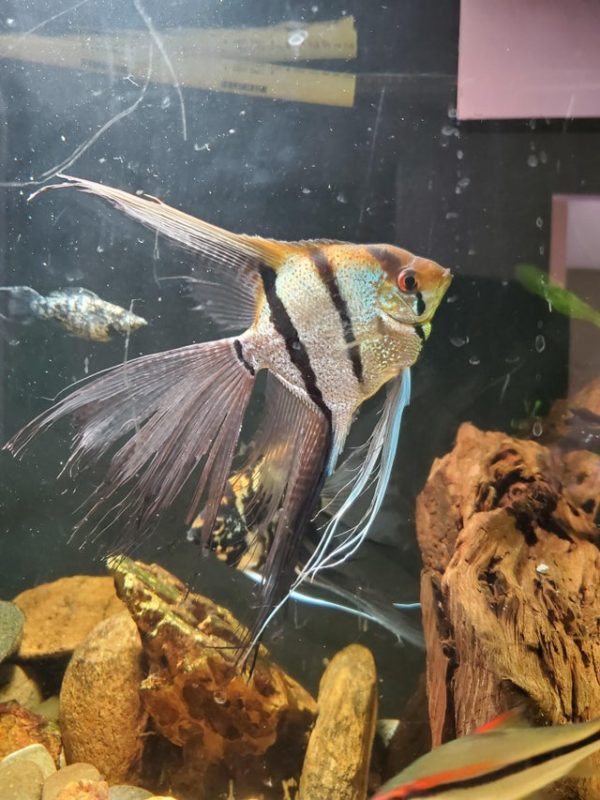
This includes paying attention to the following:
- Water temperature: 76 to 82 degrees Fahrenheit
- pH levels: 6.5 to 7.5
- Water hardness: 5-13 degrees.
Not just the technical parameters, even the decoration, and tank set-up matters. An empty tank with no plants, substrate, or gravel will affect their lifespan exponentially. So, try to spruce up the space with larger live plants like Java Fern, Mosses, etc.
Although frequent water change isn’t ideal, you have to clean the tank at least once every two weeks. Of course, this will vary depending on the other fish species in the tank too. However, ensure no waste deposition and algal growth in the tank.
4. Keep Feeding High-Quality Foods
An angelfish’s feeding habits reflect on their well-being. Although they are omnivores, they are heavily reliant on live foods. So, items like fish flakes, pellets, brine shrimps, etc., make a good meal. You can also add plants to their diet now and then. For example, lettuce and spinach make good choices.
Angelfish feed around 3-4 times every day. But avoid overfeeding them. Only give them food they can gobble down in a minute. Overfeeding can minimize their lifespan, especially due to excess waste products in the water.
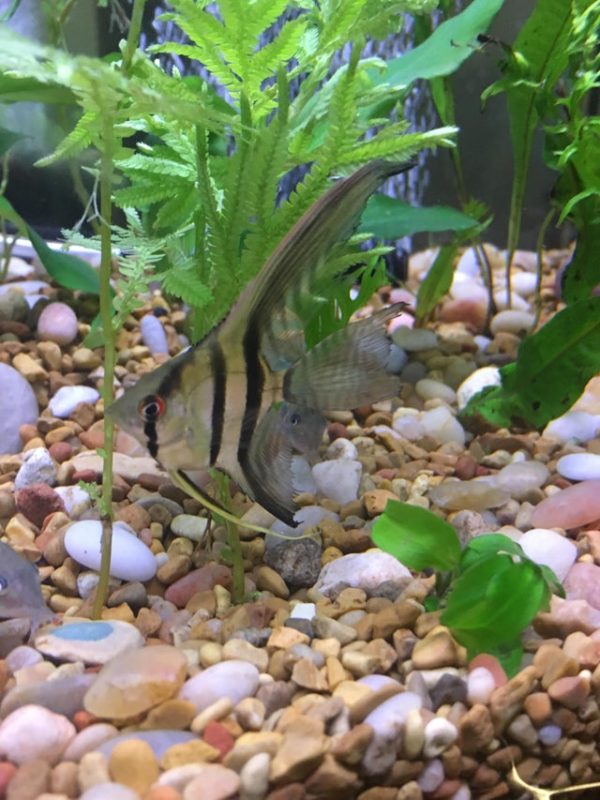
5. Reduce the Triggers
Angelfish can exhibit signs of distress due to unhealthy water parameters, poor feeding habits, or if they are in a small space. Overcrowded tanks leave them under stress and make them aggressive.
So, when keeping them, try to either limit the number of fish you add or get a larger tank to accommodate them.
Putting too much angelfish in a small tank will risk biting, fin nipping, and aggression. Aso, they don’t make the best tank mates to every species, so be selective about that.
6. Check for Diseases
Like in the wild, angelfish have risks of contracting diseases like Ich and Gold Fish disease. They can also have dropsy, mouth fungus, etc., which are fatal.
So, before buying, check for these diseases. Also, before you add them to the tank, check for signs of these diseases and quarantine them accordingly.
Which Lives Longer? Male Or Female Angelfish
Sexual dimorphism in an angelfish is difficult. This means that you wouldn’t be able to distinguish the male and female angelfish in the tank.
So, there is no proven evidence of which gender of fish lives longer. It is the overall living condition that determines their lifespan.
However, instances show that frequently bred female angelfish have a shorter lifespan. But, that is also a very rare occurrence.
Angelfish Lifespan Without a Filter
Like any fish species, angelfish don’t do well in the tank water with high ammonia and nitrate levels. So, lack of a filter in the tank will lead to diseases complications and drastically affect their immunity.
The accumulated waste and dirt in the water can also lead to complicated and fatal diseases like Ich.
Typically, an angelfish can live up to 10-12 hours in the aquarium without a filter. So, we would recommend not removing them at all.
Angelfish Lifespan Without a Heater
Freshwater angelfish are a tropical fish species. This means that they have an innate affinity for warmer water.
If you live in countries with cloudy and cold weather, a water heater in the tank is a must. Typically, the water temperature should be between 72 to 86 degrees Fahrenheit. Anything less will alter their growth and lead to stunted angelfish growth.
More than two weeks without a water heater will result in the death of the angelfish in the tank.
Wrapping Up
If you were confused about the average lifespan of an angelfish, we hope this article answers all your queries. Several factors contribute to their lifespan, including their genetic lineage and the water parameters.
So, use these strategies to reflect well on their lifespan. Also, with a lifespan of up to 12 years, you can make a friend for life, provided you give them all the care they need to grow.
